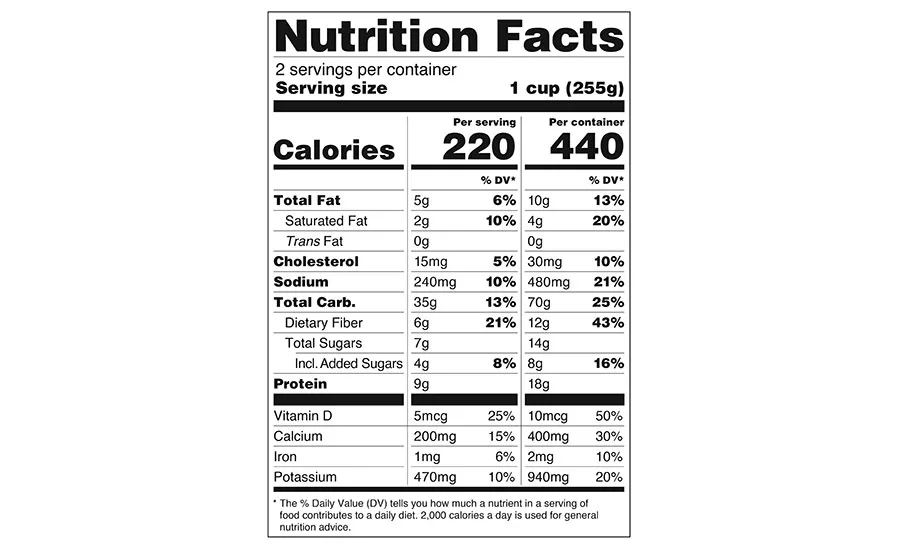Manufacturing News
Who reads nutrition fact labels?

FDA’s proposed dual-column label (per serving and per container) shows consumers the bad news if they eat the item all at once.
Source: FDA
FDA has taken another look at food labeling with two recent draft guidance documents, the first regarding serving sizes and dual-column labels and the second on nutritional information pertaining to added sugars, vitamins and minerals.
FDA’s first draft guidance (released in November 2018 with a 60-day comment period) is entitled “Draft Guidance for Industry: Serving Sizes of Foods That Can Reasonably Be Consumed at One Eating Occasion, Reference Amounts Customarily Consumed, Serving Size-Related Issues, Dual-Column Labeling, and Miscellaneous Topics.”
FDA’s second draft guidance is “Nutrition and Supplement Facts Labels Questions and Answers Related to the Compliance Date, Added Sugars, and Declaration of Quantitative Amounts of Vitamins and Minerals.”
Notably, FDA’s proposal for a dual-column nutrition facts panel is designed to help those who purchase a container with more than one serving understand what they are consuming should they eat the whole contents as though it were a single serving. FDA last redesigned the nutrition facts label in 2016 to “make it easier for consumers to make better informed food choices.” However, two studies conducted four years apart suggest labels need some improvement as a convenient information source.
In 2014 research for FDA by Tobii Pro Insight, an eye-tracking study followed the label reading habits of 60 shoppers in two different grocery stores while they visited the cereal, soup and snack aisles. The results indicated that only one-third of participants viewed the nutritional contents label at least once. The eye-tracking data also found that among those participants, the actual time spent viewing this information was less than one second.
According to Tobii, these findings suggest there is room for improvement in conveying important nutritional data at the point of sale while consumers primarily concentrate on other visual clues such as brand name, product name, imagery and pricing.
Are the nutrition/ingredients panels helpful? According to the study “Food Labeling Survey-January 2019” from the International Food Information Council (IFIC) and the American Heart Association, 95 percent of Americans reported they always or sometimes look for healthy options when food shopping. Consumers said they tend to consult food labels for healthfulness when buying a product the first time.
Unfortunately, most consumers often found it difficult to glean information about healthy foods. Only 28 percent said finding healthy foods is easy, while 11 percent noted it’s difficult. The remainder of those surveyed in the report said it’s only moderately easy to find the information they need to make informed choices.
“We know consumers are making efforts to eat healthier,” says Joseph Clayton, CEO of the IFIC Foundation. “But our research indicates that their ability to locate the information they find most helpful can be a barrier to making healthier choices. Even subtle changes to food labels could have a positive impact on public health.”
For the vast majority of consumers, the nutrition facts panel and ingredient list are the most important sources for comparisons of foods—whether in-store, online or in other marketing statements. In the IFIC study, the nutrition facts panel was perused by 69 percent of consumers while the ingredient list was read by 67 percent of respondents. Beyond those two sources, 56 percent of consumers also looked at nutrient content claims on the package. More consumers (45 percent) primarily consulted labels for ingredients they were seeking while 31 percent studied the labels for ingredients they were avoiding.
The IFIC research found that consumers pay a lot of attention to health-related iconography on food labels, but even more information could prove helpful. Nearly half (48 percent) of respondents said they frequently look for front-of-package icons, such as Facts Up Front or the American Heart Association’s Heart-Check mark. About three in five (62 percent) are at least somewhat familiar with the Heart-Check symbol, with millennials being the most aware.
Could a universal “healthy” icon on food packages help consumers make better dietary choices? Fifty-four percent said yes, and 45 percent noted it would make them more likely to purchase a given product, especially among those who traditionally shop for healthy foods.
The IFIC study found that consumers are somewhat more trusting of health-focused organizations than of government agencies, and much less trusting of food companies in terms of statements made on the food packaging. Only one in 10 had a low trust of health-focused organizations, about one in six a low trust in government agencies (e.g., FDA), and one in four had low trust in food companies providing useful information on food packaging.
Looking for a reprint of this article?
From high-res PDFs to custom plaques, order your copy today!








